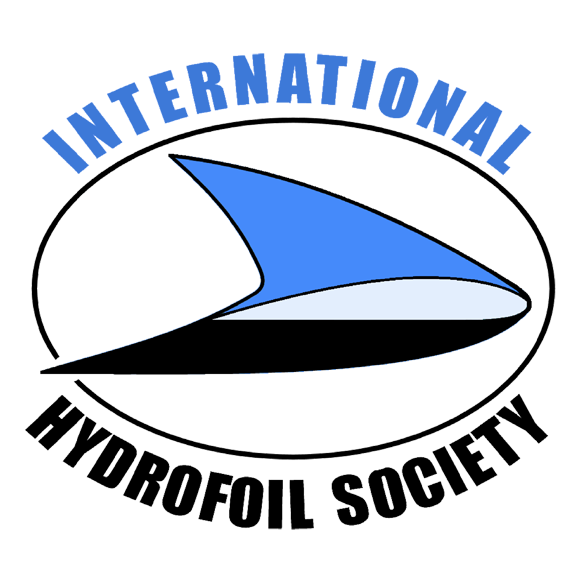International Hydrofoil Society Presents…
Books About Hydrofoils — Click HereVideos and Films About or Showing Hydrofoils — Click Here
For Hydrofoil References in Technical Journals, Papers, and Books, Click Here
For More Bibliographies, Especially Sailing Related, Try the IHS Links Page)
Frequently Asked Question: How do I get a copy of these out-of-print articles?
Answer: Try local libraries, used book stores and antique shops. IHS has used the Canadian company “Smelly Old Books” (contact: John Muxlow) to obtain reasonably priced copies of articles back to the 1920s and earlier (S.O.B. has an almost complete collection of Mechanix Illustrated, Popular Mechanics, and Popular Science). To buy old magazines, try the on-line auction services at Ebay, Amazon.com, and Yahoo… particularly Ebay. Sooner or later, just about everything shows up for sale on Ebay.
Navigation Links:Glossies – Newspapers – Hobbyists – History – Ferries – Military – Yachts/Sailboats/Motorboats – Models – Seaplanes
| LIFE Magazine 9/27/54. Cover: “Canada’s Hydrofoil — Revolutionary Idea For Navies.” photo is of Canadian hydrofoil R-100 MASSAWIPPI before foils were modified. This 45-foot, 5 ton demonstration craft was instrumented to collect data for design of larger, operationally capable ships. When heavily loaded, the original foils (shown in the LIFE cover) produced violent “porpoising” at 40-50 knots. This problem was solved by a complete redesign of the foil system. According to IHS member Jean Buhler, the LIFE cover photo was taken just before MASSAWIPPI “struck a railroad tie (end on, thank goodness!). The late Mike Eames is at the helm, and the man in the seat beside him looks like USN CDR Jim Stillwell.” Article on pp 56-60, “Boats That Fly Atop the Water.” Photos and descriptions of LANTERN (built by Hydrofoil Corp, Annapolis MD), KC-B (named for F. W. “Casey” Baldwin), XCH-4 (John H. Carl & Sons), HD-4 (Alexander Graham Bell, age 72, at the controls with co-designer Casey Baldwin and Baldwin’s young son), German patrol boat VS-6, von Schertel tourist boat PT-30 (on Lake Maggiore), US Navy’s HIGH POCKETS, Gibbs & Cox 20-ft hydrofoil, and WING (a German sports boat that sold for US$6,370). |  |
| LIFE Magazine 7/26/63, “Exclusive Picture Log of a Mad Maiden Voyage”, pp NY2-NY8 (New York Extra Section). Nine large B&W photos by Dan McCoy. Excerpts from the text: “It was the maiden voyage of the ALBATROSS and the dawn of a sparkling new era in New York commuting… aboard were the city’s first hydrofoil commuters — 24 passengers bound out of Port Washington for Wall Street. But barely had these sea=going commuters settled back in their seats… when a crazy saga started to unfold. Before the ALBATROSS finally reached lower Manhattan they had taken part in a dramatic rescue, found themselves face-to-face with some stranded celebrities, and then, as the whole improbable voyage was about to end, almost lost their leader…” The rescued celebrities were movie producer Sam Goldwyn and his wife, and investment banker Robert Lehman, who were floundering off Steppingstone Light. “‘I’ve made movies with less excitement,’ observed Mr. Goldwyn.” A little later, the president of American Hydrofoil Lines Ira E. Dowd stepped out on deck to watch as a Coast Guard vessel approached and he toppled overboard. All ended well, however; he was pulled back aboard, his suit dripping wet, but otherwise OK. |  |
| Brooks, Alec N., Allan V. Abbott, and David Gordon Wilson, “Human-Powered Watercraft,” Scientific American, December 1986. Features cover artwork showing the Flying Fish II human-powered hydrofoil. This issue includes an eight page article (pp 108-114) about this craft and a range of other human-powered vessels with illustrations and graphs. |  |
| “The Speediest Boat,” National Geographic, Sep 1911, pp. 875-878. Article includes two B&W photos of Enrico Forlanini’s hydrofoil craft and describes how Alexander Graham Bell traveled 45 mph on Lake Maggiori in this craft. Forlanini patented his hydrofoil under the descriptive name of “appareccio idrovolante.” The article quotes Scientific American as saying, “After six years of experimenting, Forlanini can how consider that he has arrived at fully satisfactory and definite results.” The weight of the successful craft, including two passengers, is cited as two tons. It was powered by a 100 hp gas engine. Hull length was 32.8 ft. |
|
| Grosvenor, Gilbert, “Hydrofoil Ferry ‘Flies’ the Strait of Messina,” National Geographic April 1957, pp 493-496. 8 illustrations (six in color). |
|
More Glossy Magazine Titles (No Photo Available)…
|
|
| Stein, Ralph, “Here Come the Hydrofoils!,” This Week Magazine, 21 July 1963, cvr, pp 6-7, 14-15. United Newspapers Magazine Corp. New York, NY. Two pages of text, five B&W photos, plus the cover illustration. Photos are of the Vingtor (Norway), Vikhr (Russia), Albatross (USA), Commutaboat I (Holland), and a typical vessel (Italy). “This summer a hydrofoil line is starting to carry commuters from the suburbs to New York. Another hydrofoil outfit is planning to make pleasure cruises at the 1964 World’s Fair. Next year, too, hydrofoils will run between Seattle and Victoria, BC. Hydrofoils will use as highways the waterways which lap the shores of most of the biggest American cities and their suburbs. They should be as cheap to ride as a bus or train and a lot more fun. Furthermore, the seem sure to change the pattern of urban and suburban living and real-estate development.” The article quotes Mr. Ira E. Dowd, President of American Hydrofoils Lines as saying, “Although the Albatross is just a model T of commuting hydrofoils, we’re starting a regular service between Port Washington, L.I. and East 25th Street in Manhattan this summer, at about $1.75 each way for the 25-mile trip. We’re building five more 24-passender boats. By 1965 we expect to have thirty-five 24-passenger boats running, and we’re planning to have a big 200-passenger hydrofoil in the water by then, too.” On the west coast, the article notes that William I. Niedermair, President of Northwest Hydrofoil expects the VICTORIA to be ready for sea trials in Jan 1964 and that he has applied for approval to operate hydrofoils as inter-island ferries starting in late 1964.” The article concludes, “Who’s going to advance the money to build fleets of hydrofoils? Under Title Eleven of the Merchant Marine Act of 1936, the Maritime Administration will guarantee a construction loan from a bank of up to 75 per cent of construction costs and then insure a subsequent mortgage, much like FHA.” |  |
Newspaper Titles (No Photo Available)…
|
|
| Fitz-Gerald, Wm. G., “To Cross Atlantic in Thirty Hours,” Technical World Magazine, Oct 1907, The Technical World Co., Chicago IL, pp 139 -142. Includes three tinted photos. “Peter Cooper Hewitt of New York is a scientist and inventor of high reputation and proved achievement. He is not given to idle and boastful talk. consequently, when he announces that by the invention of a boat supported above the water by gliding planes he has made possible the building of ocean liners which may easily reach a speed of one hundred miles an hours, even conservative men are ready to believe the statement. To cross the Atlantic in thirty hours is the goal at which Mr. Hewitt is aiming… with the added marvel that seasickness also will be relegated to the limbo of forgotten horrors, because no longer possible! …the only problem that remains at present is that of the propeller… yet the idea is not new… forty years ago the British Government was experimenting with a device that showed how a craft would lift if it had inclined planes made fast to its hull. So wonderful were the possibilities that private inventors speedily took a hand, among the Raoul Pictet, whose water ‘flying machine’ amazed the Swiss about the classic shores of Lac Leman.” |  |
| “Ocean Skimmer for Atlantic,” Modern Mechanics, March 1930. p.79. “At last the “stepladder boats,” as the hydrofoil speeders planned by the son [sic*] of Dr. Alexander Graham Bell have been called, are to make a bid for laurels as the fastest method of crossing the Atlantic. They are to be placed in regular service soon, according to plans of the inventor, and already the preliminary engineering, based on many model and full sized tests, has been done. Tomorrow we may be able to ride in one of these super luxurious liners. We will embark in New York in the evening, and the same time a day later find ourselves flying over the water up the English Channel, having clipped three full days from what was formerly the world’s record for trans-Atlantic passages.”
* The article erroneously refers to engineer and Bell associate Casey Baldwin as Bell’s son. |
 |
| “Ocean Liners With Water Wings,” Everyday Mechanics, Oct 1930, Vol. 2, No. 7, combined with Illustrated Science & Mechanics, published by Hugo Gernsback, Chicago IL, p.279. Two artist conception sketches and a paragraph of descriptive text occupying one half page. “Europe in two days is the aim of the designer of this novel hydrofoil ocean liner. Small wings, like those on an airplane, immersed in the water cause the huge boat to rise as it accelerates in speed until it virtually leaves the water – only the keel and wings being submerged… True, the boat has not been built as yet, but experiments with small boats have already been conducted which proved the soundness of the theory. Of course, this ship may not be as comfortable as the present liners, but it will save time.” |  |
| “Ship on Stilts Rides Above Waves,” Popular Science, January 1936. “Ocean liners on stilts are proposed by a Portland OR inventor to offer travelers safety and comfort at sea. His design envisages a craft supported by buoyant submarine pontoons, in such a way that the hull itself rides clear of the water. its elevation above the surface would be sufficient to allow heavy waves to pass beneath it without striking it, eliminating the buffeting to which most ships are subjected in bad weather. Rolling and pitching would thus be minimized. The streamline pontoons are so arranged that they rest in a calm level below the surface layer of disturbed water, and their broad, flattened upper and lower surfaces resist any sudden vertical movement. The propeller is situated nearly amidships, and the tunnel-like enclosure formed by the surrounding pontoons is declared to give high propulsive efficiency. The added weight of the pontoon structure would not be as great as might be imagined, since the elimination of heavy shocks and strains upon all parts of the ship would permit the extensive use of lightweight alloys in its construction.”
|
 |
| “Boat Rides on Underwater Wing,” Popular Science, April 1939, Vol. 134, No. 4, p. 124. description and two drawings of the Wsevolode Grunberg hydrofoil concept. Excerpt from the article: “…a curious, airplane-type speedboat… is supported by a specially designed central keel, supplemented by two forward pontoon floats. Plans for the novel water craft call for a hull that resembles the porthole-studded fuselage of a giant transport plane, surmounted by a strut-supported engine whirling twin propellers, one facing toward the bow and the other toward the stern, to furnish both a pushing and a pulling force. The majority of the craft’s weight is supported by a horizontal wing-shaped surface extending out at either side of the rudder, near the base of the keel. lateral stability of the craft is obtained by the bow pontoon floats, which are connected through shock absorbers to adjustable horizontal members in the form of ailerons jutting out from the prow of the ship. The weight of the vessel… is so distributed that the ship always has a tendency to nose-dive… the pontoon floats automatically keeping the craft on an even keel, since the farther they are pushed down into the water, the greater their lifting force… the inventor points out that it would be possible to use the floats as reservoirs for fuel…”
|
 |
| Armagnac, Alden P. , “100 Knot Liner Has Sea Wings,” Popular Science March 1959; Drawings by Bob McCall. “An ultra-fast new way to travel, in vessels that ride high above the waves, is promised by the conquest of the sea’s speed limit.” p106-113, 238, 240, 242. “Transocean A-Liner – Atomic propulsion is entirely contained in a pod attached to the center strut… supercavitating foils, while inefficient at moderate speeds, begin to show spectacular superiority above something like 70 knots… Accommodations will be much like those for an overnight trip by rail — individual staterooms, or roomettes. Such fancy trimmings as ballrooms and swimming pools will be superfluous; and your fare may pleasantly reflect the savings in operating cost…”
|
 |
| Gallager, Sheldon M., “Now You Can ‘Fly’ Your Own Outboard, Popular Science, June 1959, pp. 178-181, 210, 212. Photos by W.W. Morris. Description of two foils kits about to come on the market at that time: the Dynamics Development (subsidiary of Grumman) kit, which was to sell for about $395 and the “Roberts kit” designed by Jim Hartley, which was to sell for between $150 and $200. Most info is about the Grumman kit. The Roberts kit can be purchased already installed with an 8 ft. pram for about $460. The Roberts kit was held on by only 8 bolts; the Grumman installation was “a little trickier.” The article advises resisting the temptation to stunt-fly because “in crowded waters, the foils’ almost razor-sharp edges could mean sudden death to an unseen swimmer.” According to the article, “controllable tabs — like tiny ailerons — allow the Grumman foils to be trimmed under varying loads, but once set do not require further adjustment. The Roberts foils are trimmed by loosening bolts to adjust their angle of attack.” |  |
| Popular Science May 1960 – “Free Blueprint Sheet one & Sheet two: Flying Platform Boat. It’s a real quickie. Make it in two weekends… for $116. 00… with a table saw… for unsinkable fun. The first time I shoved the throttle forward on this little 4 ft. by 8 ft. fun boat, it took my breath away. In an instant, I found myself flying more than a foot above the water on homemade hydrofoils, going faster and faster… In calm water, with a 10-hp long-shaft motor, I flew the crazy little craft at 35 mph…. Next month (June 1960) you’ll get detailed instructions for mounting these same foils on any runabout up to 16 feet. An 18-hp long-shaft motor was used to fly a 14-footer. With two passengers in the front seat, the foils were carrying a gross weight of nearly 1,000 lbs. And best news of all for you: the foils can be made for less than $25, including their supports.” |  |
| Pfister, Herbert R., “How I Fitted Oak Hydrofoils To My 14-Foot Runabout,” Popular Science June 1960. “The most exciting water sport today is hydrofoiling. It’s boating, but different. Underwater wings lift your boat out of the water and you take to the air – or so it seems. Freed from the water, the boat rides smoother and faster on less power. If your boat is 16 feet or less in length, there’s a good chance you can equip it with foils. If you can work with wood, you can make foils. You shape them on a table saw. You’ll find the details illustrated in last month’s Popular Science. There’s also a big blueprint to help with the job. Photos and drawings show how I fitted foil supports to the sides of my 14-foot plywood hull. Broad braces on the supports distribute strain over a wide area, making the installation equally suitable for thin-skinned aluminum and fiberglass boats.” |  |
| Armagnac, Alden P., “Seagoing Hydrofoils Fly Over Waves at 60 Knots,” Popular Science July 1961, pp 56-59, 187-188. From the article, “This summer will see the completion of the HS DENISON for the Maritime Administration at an Oyster Bay NY shipyard. Its 80-ton size ties the record for foilborne vessels, and it will be the first ocean-going one. And the keel has been laid for the biggest hydrofoil ever built — the seagoing 110-ton subchaser PC(H)-1 due to joint the Navy next year.” The article also includes small B&W photos and text description of other hydrofoils, including the teardrop-shaped LANTERN, the FLYING DUKW, HALOBATES, XCH-4, and XCH-6. |  |
| Armagnac, Alden P., “60 Knot Hydrofoil, 90 tons of get-Up and Go,” Popular Science Monthly, Nov 62, pp 55-58, 180. “The fastest ship afloat will open a new era of high-speed ocean passenger service… With a thunderous roar and a faint trail of jet-fuel smoke, the extraordinary 104-foot vessel has been streaking by at an incredible 70 mph and more. As if to show it is really a ship and not some kind of waterborne missile, it has been seen executing graceful S-curves and U-turns at high speed, in a shower of spray. The flying phantom ruffles the water so slightly, despite its express-train velocity, as only gently to rock the smallest boats nearby… Long Island’s mystery vessel is the fastest ship in the world. Named the HS DENISON, she’s the first of a new generation of big US hydrofoils, both commercial and naval… A mighty gas turbine continuously delivers 14,000 hp, giving the craft its speed. Adapting such aircraft-type engines to propel hydrofoils is a major US advance.”
Joseph, James “Riding a Hydrofoil… Smo-o-oth,” Popular Science Monthly, Nov 62, pp 58-59. “Throttle open, ALBATROSS will carry 24 passengers, plus a crew of two. The first craft of this new US type has been successfully tested in trial runs. It’s expected to be put in service soon on a California route. Five craft are being produced initially by their designer and builder, Hydro-Capital Corp. of Newport Beach CA. Within a few more months, the firm hopes to have 15 of the boats flying.”
|
 |
| Martenhoff, Jim, “I ‘Flew’ an Outboard Hydrofoil,” Popular Science Nov. 1965, pp 79 – 81. Text and 4 B&W photos. The author describes is test ride on a 15′ aluminum Starcraft with 40 hp outboard and surface-piercing hydrofoils. According to the article, the hydrofoils were an accessory kit developed by “an American-owned Swiss corporation Supramar” and designed to fit any powerboat from 14 ft. to 20 ft. in length. Total weight for the foil kit was 140 pounds, 60 pounds for each of the foil assemblies mounted forward, plus 20 pounds for a small foil assembly at the stern. This was a test set of foils made of carbon steel, but stainless steel was planned for the production model. The rear foil assembly was permanently mounted to the hull for the test, a disadvantage because it makes trailer launch impossible. The side mounted foil assemblies can be raised out of the water by hand. The production model planned to include hydraulic retraction of all three foil assemblies. The foil angle of attack is adjustable from within the cockpit over a range of 3 degrees to compensate for changing loads. The author describes a crash landing that occurred during the test due to striking a piece of wood flotsam… no damage to the foils, and the strike was not severe enough to shear the safety pin. The installed price of the planned production kit would be $400 per boat. According to the author, “it is doubtful that fishermen would go for it: those foils are just something else to wrap a line around.” | 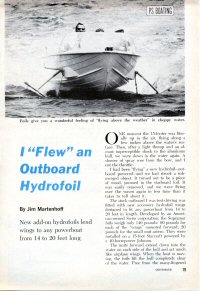 |
| “James Bond’s Weird World of Inventions,” Popular Science, January 1966, pp. 60-63. “Thunderball’s prize piece of gadgetry is a $300,000, 64-foot hydrofoil yacht… production designer Ken Adams couldn’t find a hydrofoil imposing enough for the wide-screen Panavision film, so he decided to build a cocoon aft on a 60-footer, nearly doubling the vessel’s length to an overall 110 feet… The cocoon can be jettisoned at the touch of a button, allowing the hydrofoil to zoom off at full speed. The hydrofoil has a 1320-hp Mercedes-Benz diesel and can hit a top speed of about 40 knots. But Adams can improve on that — by filming it at one-third normal camera speed. Normal projection speed makes the DISCO VOLANTE appear to do over 100 knots.”
Also in this issue, on page 82, is this news blurb with photo: “You can now order the 16′-4″ Larson Volero in hydrofoil-equipped models. so outfitted, the popular stock outboard runabout is capable of speeds topping 45 mph with a 60- or 75-hp motor on her transom. You swing the foils up for normal running by adjusting a hand control in the cockpit near the wheel. The boat is produced in Little Falls MN.” [This hydrofoil version was never produced, according to the Larson company – Editor] |
 |
| Brown, Stuart F., “World’s Fastest Sailboat — Two Masts and Three Self-Adjusting Underwater Wings Make For One Rapid Hydrofoil.” Photos by John B. Carnett. Popular Science, Volume 238, Number 1, January 1991. ISSN 0161-7370, Times Mirror Magazines Inc, New York, USA. This issue contains an article on the world sail speed record holding trimaran hydrofoil craft (trifoiler) LONGSHOT designed and built by engineer Greg Ketterman for racer Russell Long. The cover photo by John B. Carnett shows LONGSHOT sailing foilborne in choppy water. A speed of 37.18 knots (42.8 mph) was achieved on Stafford Lake in Lethbridge, Alberta while piloted by Russell Long. At the time, this was the all-out world record for sailboats (100 square foot sail area or more), though even at that time the speed for wind surfers (under 10 square metres of sail area) was significantly higher at 49.4 miles per hour. In the article, Ketterman indicated it should be possible to exceed 50 mph when sailing LONGSHOT in strong steady winds. | 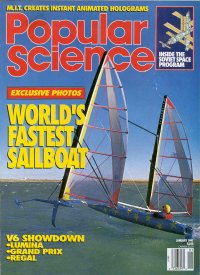 |
| Jackson, William D, Naval Architect, “Build Your Own Hydrofoil Speedboat, ” Science and Mechanics Feb 1960, Craft Print Project No. 304. p.176-179. Plans for building add-on hydrofoils for almost any boat up to 16 feet. The designs are “the result of designing and testing many different types and sizes and shapes of hydrofoils over a period of several years.” Foils are constructed of steel framework with fiberglass foil-shaped lifting surfaces. The next (Apr 1960) issue has plans to build the boat used to test these add-on foils. | 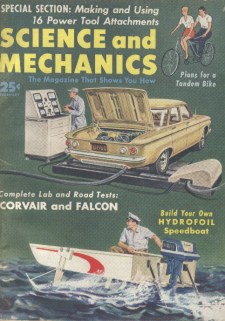 |
| “Jet Hydrofoil Shoots at World Record,” Popular Mechanics, August 1953, pp 70-71. Five B&W photos of Frank and Stella Hanning-Lee’s WHITE HAWK. From the accompanying text: “…two Britishers, Mr. and Mrs. Frank Henning-Lee [sic], aim to break that speedboat record with their jet-powered craft, the WHITE HAWK, on Lake Mead, Nevada, this fall. The man-and-wife team collaborated on the design. Mrs. Henning-Lee [sic] (an American by birth) is the driver… Top speed of the boat to date is 125 miles per hour. But that was loafing along on a stability run in England. when Stella Henning-Lee [sic] opens it up on Lake Mead, she is certain that the speed record… will be held, for the first time, by a woman.” | 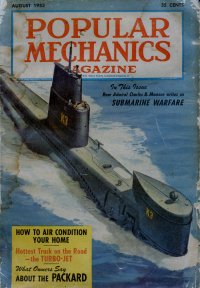 |
“Carnival of New, Way Out Watercraft,” Popular Mechanics, July 1963, pp 83 – 85. Among the watercraft depicted are two hydrofoils:
|
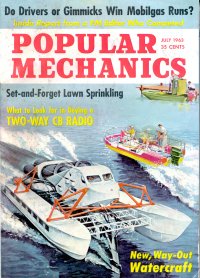 |
| Popular Mechanics September 1967 – An 11.5 ft. one-person hydrofoil developed by Italian designer Rentato Castellani of Verbania can hit 35 mph with an 18-hp outboard engine. The steerable front foil permits tight turns and thrilling acrobatics according to PM. The fiberglass hull is foam-filled and unsinkable, plus it comes apart for easier carrying. The designer intended to sell this craft in kits, but IHS is unaware of any that were sold. Anyone with more information about the fate of this design is encouraged to contact IHS.
|
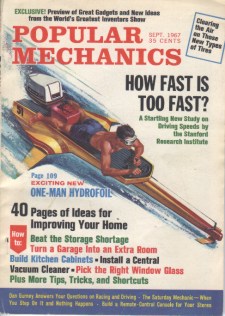 |
| Zimmerman, Bob, “The Biggest, Fastest ‘Flying Boat’ Yet!” Popular Mechanics December 1968. Technical art by Fred Wolff. “It’s 212 feet long and displaces 300 tons, but when it goes up on “stilts” it skims across the water — even heavy seas — at better than 40 knots… the PLAINVIEW, made by the Lockheed Aircraft Corp., is the largest hydrofoil ship ever built… it is intended to do the work of a destroyer. A hydrofoil could become the only surface ship that can outrun and outmaneuver a nuclear submarine. It would be large enough to carry sophisticated detection and tracking gear and torpedo launchers. In a foilborne chase, it would be immune to the bouncing and tossing that can interfere with the accuracy of weapons systems in a conventional ship traveling at high speed… Other promising areas are mine warfare, recon missions, amphibious assaults, short-haul transportation of personnel, and oceanography.” |  |
| “Hook’s Hydrofin – Boat Rides on Stilts,” Mechanix Illustrated, Apr 1952, pp. 84-85. “The basic elements are a fuselage (completely out of the water while the boat is in motion), three fins or hydrofoils (under the surface) which are connected to the fuselage by supporting struts or hydropeds, and of course, a power plant. Then, there are two forward projecting stilts, called jockeys, which predict the water surface in front of the foils… Standard Hydrofin production models are 12-1/2, 18-1/2, and 24-1/2 feet long, carrying 2, 5, and 10 people… The manufacturers — Atlantic Hydrofin Corporation of Miami FL… “ | 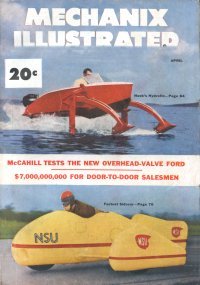 |
| Mechanix Illustrated Nov 1962, HS DENISON — “World’s First Ocean-Going Hydrofoil — New US Wonder Ship To Top 90 Miles an Hour! The HS (Hydrofoil Ship) DENISON, which has flown over the water at 50 knots and which, it is hoped, will do as high as 80 knots (or about 90 mph in landlubber lingo) will be the first operational; ocean-going hydrofoil ship in the world… Development was undertaken jointly by the Maritime Administration and the Grumman Aircraft Engineering Corp. Fifty-seven contractors took part. After a thorough test program to be conducted by Grumman, the ship will be turned over to the Maritime Administration, which will charter it to Grace Lines for use as a passenger ship. Carrying 60 passengers, the DENISON will fly between Florida and the Bahamas. | 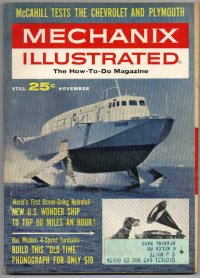 |
| “All about Hydrofoil Craft,” Practical Mechanics, Aug 1961. A survey article of hydrofoil craft in service at the time, in Russia, Switzerland, Italy, Scandinavia, Japan, and South America. From the article: “Until 1959 the Shell Oil Company of Venezuela relied on orthodox high speed launches to carry workers out to the drilling rigs 40 miles off-shore on Lake Maracaibo. Now they have PT 20 hydrofoil boats which carry the same load of 66 passengers at the same speed, on well under half the horsepower… larger PT 50 boats are now working between La Guaira on the Venezuelan coast and Isla de Margharita, 120 miles away in the Caribbean Sea… the River Rhine Police have used hydrofoil launches since 1954… the Suez Canal Authority uses a hydrofoil inspection launch…the Soviet authorities plan to have 285 [hydrofoil boats] in operation on rivers and lakes by 1965… There is of course no possibility of putting ships like the CANBERRA or the QUEEN MARY on foils. The latter would require two million horsepower to make use of them, ten times her present engine room output.”
Granberg, W.J., “America’s First Hydrofoil Ferry,” Mechanix Illustrated, Jul 1961, p.75. One page consisting of a paragraph of descriptive text and three B&W photos of the FLYING FISH, which operated a ferry route between Bellingham WA and Victoria BC Canada. According to the article, FLYING FISH was a “65-ft., 60-passenger aluminum-hull hydrofoil ferry boat, the first of its type to operate in American waters. Hydraulic controls in the wheel house adjust foil angles for maximum performance under particular weather conditions and at various speeds. The Italian-built craft carried passengers between Italy and Sicily before being purchased and brought to the USA by Dr. Frank A. Colderone of Hempstead NY.” Mechanix Illustrated, Jan 1959. Contains article on hydrofoil boat design. No details available. |
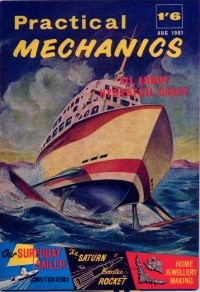 |
More Hobbyist Magazine Titles (No Photo Available)…
|
|
| Classic Fast Ferries – “the ‘Cyberzine’ about hydrofoils, catamarans, air-cushioned vehicles (ACVs), and other classic fast ferries. This is an on-line magazine in Adobe Acrobat format, free of charge. Current and past issues can all be viewed, printed, and/or downloaded from the Classic Fast Ferry website, editor Tim Timoleon. |  |
| “US Navy on Stilts,” Sea Classics, Jan.1974. Has article on Navy PHMs, also “Hydrofoils of the Third Reich.” |  |
| von Schertel, Baron Hanns, “Hitler’s Hydrofoils,” The Best of Sea Classics, Summer 1975 and Sea Classics Jan 74, Challenger Publications, Inc. Canoga Park CA, USA, pp 4-9, reprinted from Aviation & Marine Magazine, France. Baron von Schertel first began experimenting with hydrofoil craft in 1927. This article gives details on German hydrofoil development during World War II. In 1939, the military first became interested in a 2.8 ton hydrofoil demonstration boat. Various hydrofoils followed that craft, including the VS 6, VS 8, VS 10, TS-1 Coastal Surveillance Hydrofoil, Single-Seat 3-ton torpedo boat, and the 4-ton Pioneer Corps workboat. | 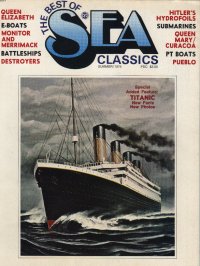 |
| Keene, Tony, “Canada’s Ill-Fated Hydrofoil Sub-Hunter,” Sea Classics, June 1991, vol. 24, No. 6, pp. 46-53. “When built she represented an entirely new and radical form of sub-hunter. But her glory was short-lived and the BRAS D’OR finished her days as an ignoble museum ship… It was the Royal Canadian Navy’s objective to produce an operational vessel, a winged anti-submarine warrior capabile of patrolling the North Atlantic sea lanes. This project, designated FHE-400, resulted in a three-phase contract being signed by de Havilland Aircraft of Canada in 1963, calling for final sea trials and the handing over of the ship to the Royal Canadian Navy by 1969 when it was felt that firm proposals would have to be made to replace the old steam frigates then in service…” |  |
More Classics Magazine Titles (No Photo Available)…
|
|
| Hovering Craft and Hydrofoil, Volume 18, Number 7, April 1979. The International Review of Air Cushion Vehicles and Hydrofoils. Was published monthly by Kalerghi Publications, London. The magazine was later published as High-Speed Surface Craft and is currently released under the title Fast Ferry International. The cover of this issue features an artist’s impression of HMS SPEEDY by Boeing Marine Systems. HMS SPEEDY was a derivative of the Jetfoil series of passenger hydrofoils and was evaluated for a period of time by the Royal Navy. Inside the issue is a six page article on this hydrofoil by Antony Preston which includes photos of HMS SPEEDY under construction at the Boeing factory in Seattle and a number of sketches of the propulsion and control systems. |  |
| High-Speed Surface Craft Incorporating Hovering Craft and Hydrofoil, October 1982, Vol. 21, No. 10. Published by Capstan Publishing Company Ltd, Surry, UK. This journal was previously published as Hovering Craft and Hydrofoil and subsequently became Fast Ferry International. While the cover of this particular issue features a high speed catamaran by Cougar Marine, it contains several articles on hydrofoil themes including: International Hydrofoil Society North American Association First Conference; Current status and future prospects for US commercial hydrofoils; Current status and future prospects for Far East commercial hydrofoils; The evolution of the NIBBIO class hydrofoil from TUCUMCARI; Reconstruction of the HD-4 hydrofoil; Unhappy debut for new Jetfoil service; and History of US involvement in developing the hydrofoil (part 3). |  |
| Pierless Magazine, Future Ferries, The Final Frontier, April 2000. Includes article on Ultra-fast hydrofoil ferry proposed by Hydrofoils Inc. |  |
| Fairplay International Shipping Weekly, Vol 274, No. 5052, 26 June 1980. Published weekly by Fairplay Publications Ltd, London. This issue features a cover photo of Boeing Jetfoil 929-115 CU na MARA, which was with B+I on a Liverpool to Dublin run at the time. The issue features a two page article by Michael Hood examining two Jetfoil services. |  |
| “Hitachi Zosen News” Volume 5, Number 6 of August 1962 (also apparently issue 30). The blurb about the front cover states: “The Port of Takamatsu on Shikoku Island is one of the key ports of marine traffic on the inland sea of Japan. In the photo is shown the hydrofoil boat (constructed by our company) connecting the Osaka and Kobe districts with Port Takamatsu.” Click Here for a close up of the PT-20 in the photo. |  |
| Ship and Boat International, Issue 96/1, January/February 1996. Published ten times a year by The Royal Institution of Naval Architects, London, UK. The cover of this issue features the second commercial example of the Kvaerner Fjellstrand FoilCat, Barca, which at the time of publication had entered service between Hong Kong and Macau with Far East Hydrofoils. The 35 metre foil supported aluminium catamaran is powered by a pair of 4485 kW GE LM500 gas turbines driving KaMeWa 80S11 waterjets through MAAG gearboxes. The craft can carry 403 passengers. While a speed of 52 knots was achieved on trials, the normal service speed is about 45 knots. This issue includes a short one third of a page article on the FoilCats. The journal from time to time features other hydrofoil production news. | 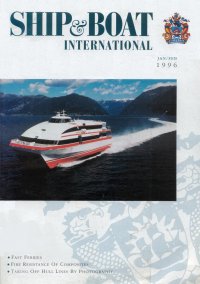 |
| Speed at Sea, The Journal for Fast Ship Operators, Volume 7, Issue 3, June 2001. ISSN 1359-4222. This Journal is published six times a year by Speed at Sea Publishing, Enfield, UK. From time to time, items related to hydrofoils or hydrofoil-assisted craft will appear in the journal. The June 2001 issue for example features a three-page review of the 54.5m hydrofoil-assisted trimaran TRIUMPHANT built by North West Bay Ships in Tasmania, Australia. The trimaran is equipped with a Maritime Dynamics, Inc. lift and ride control system for which the lifting surfaces consist of a pair of hydraulically actuated foils between the main hull and side hulls as well as trim tabs aft on the centre hull. The foils not only improve the motions of the vessel in waves, but additionally provide lift thereby enhancing the overall performance of the ship. | 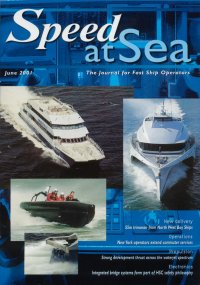 |
| Work Boat World, Volume 21, Number 7, October 2002. ISSN 1037-3748. This Journal is published twelve times a year by Baird Publications Ltd, Hong Kong. As with other such journals, items will occasionally feature hydrofoils or hydrofoil-assisted craft. The October 2002 issue features a one-page review of the 40.2m hydrofoil-assisted catamaran ‘Linda’ built by Almaz Marine yard in St. Petersburg, Russia. The catamaran is equipped with a pair of bow foils and the sterns of the demi-hulls support the remaining weight and incorporate a pair of waterjets. | 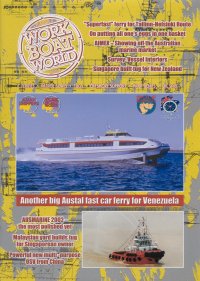 |
More Commercial Hydrofoil Magazine Titles (No Photo Available)…
|
|
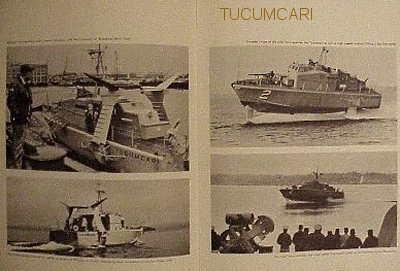 |
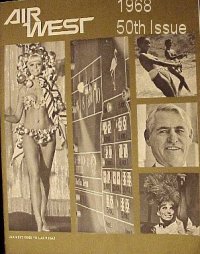 |
| Shethar, Alan, “Wings Upon the Water: The Hydrofoil,” All Hands, The US Navy Bureau of Personnel Career Publication, Jul 73, pp2-7. Photos and text descriptions of PHMs, AGEH-1 PLAINVIEW, PCH-1 HIGH POINT, and PGH-2 TUCUMCARI | 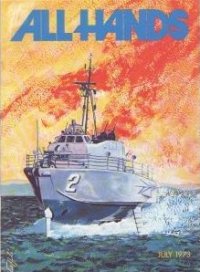 |
| Christy, John, “Punch-Packing Sea Skimmers,” International Combat Arms, May 1985, Vol. 3, No. 3, Petersen Publishing Co., Los Angeles CA 90069, pp 39, 68 – 74. Lots of good photos. From the text: “…by the time the NNAG studies, with input from as many as 11 navies, were completed and the three signatories to the “Memorandum of Understanding,” the U.S., Italy, and the Federal Republic of Germany, had completed the signing, the size of the projected vessel had doubled. With all the performance factors cranked into the equation, and all the machinery and weapons added, the 74-foot prototype design had grown to 130 feet with a hullborne tonnage of 224 tones (39.5 meters and 228 tonnes). Cost factors were commensurate with the increase in size, and by 1974, Ital and the FRG had opted out, leaving the U.S. and Boeing to go it alone. The Italians downscaled their requirements and made a license agreement with Boeing to use the original TUCUMCARI design, modified for missile use, and the Germans decided on the Luerssen S 143 hullborne FPB…” | 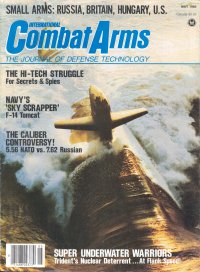 |
| Naval Engineers Journal, Volume 95, Number 5, September 1983. ISSN 0028-1425. Published by the American Society of Naval Engineers, Inc. (ASNE). This issue features a cover photo with all six PEGASUS class PHMs flying together for the first time in US Navy history. The mission took place off Key West, Florida, where all the hydrofoils were stationed. Photo was provided courtesy of William M. Ellsworth and PHM Squadron 2 based in Key West. The caption for the photo also indicated that it would be unlikely that all six hydrofoils would operate together again, as some would be rotating through shipyard cycles. The Naval Engineers Journal from time to time has included technical articles related to naval hydrofoil design. | 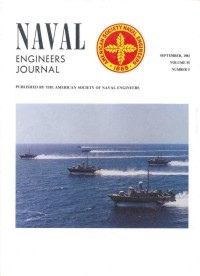 |
| Naval Engineers Journal, Volume 97, Number 2, February 1985. ISSN 0028-1425. Published by the American Society of Naval Engineers, Inc. (ASNE). This special edition features comprehensive reviews of a range of ‘advanced naval vehicles’, including hydrofoils, Surface Effect Ships (SES), Wing-in-Ground Effect (WIG) craft, Air Cushion Vehicles (ACV), Small Waterplane Area Twin Hulls (SWATH), planing hulls, and modern monohulls. This is an ideal source of background information in considering the merits of different craft types for particular roles. | 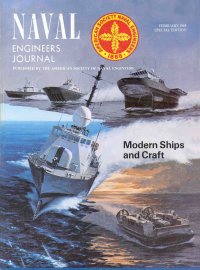 |
| Naval Forces, Vol.VI, No.2, 1985. Published by Monch Publishing Group. Features cover photograph showing the USS Hercules. Although this issue does not contain an article on the PHM class, the journal does deal with naval hydrofoils from time to time. The blurb for the cover photo states: “The USS HERCULES (PHM 2), one of the six patrol hydrofoil missile craft which were built by Boeing Marine Systems in Seattle, Washington. They are currently operational with the US Navy in the Caribbean with PHM Squadron 2, at Key West, Florida. The squadron became operational in 1983. These craft are capable of over 40 knots and are armed with eight Harpoon missiles, one Oto Melara 76 mm gun and Mk 92 fire control system. This issue does contain one small black and white photo of a Chinese Huchuan class hydrofoil torpedo boat as part of an article on the Chinese navy (Hu Chwan is an alternate spelling for this boat class; it means White Swan). | 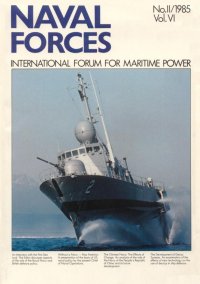 |
| Copeland, Earl Jr., “Hydrofoils,” National Defense, Mar-Apr 1970, Vol. LIX, No. 329, published by the American Defense Preparedness Association, Washington DC. pp 382 – 386. Survey of the state of the art for hydrofoils at the time of publication. Discussion and photos of PHM-1 PEGASUS, FLAGSTAFF and SUPER FLAGSTAFF (concept), DENISON, PLAINVIEW, HIGH POINT, Philippine Navy Patrol Craft, H-890, RHS-140 ferry, Italy’s SWORDFISH and PAT 20, seagoing PT-150, PT-50 BALSA SEAWING, Seaflight L90 ferry, Canada’s BRAS D’OR, and TUCUMCARI. Discussion without photos of BUREVESTNIK, BYELORUS, CHAIKA, CYCLONE, DELPHIN, LUCH (Ray), MIR, NEVKA, STRELA, Kometa, Meteor, Pchela (Bee), Raketa, Sputnik, Typhoon, Nikhr (Whirlwind), Volga, Molnia | 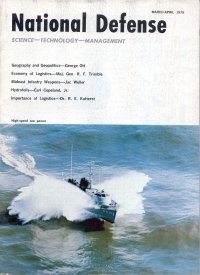 |
| “Israel’s Hydrofoils,” Defense Update International, Born in Battle, No 66, 1985. No further info available. |  |
| International Defense Review, Volume 16 No. October 1983. ISSN 0020-6512 (SZ), Monthly journal published by Interavia S.A., Geneva, Switzerland. In English, French, German and Spanish editions. This issue features a cover photo with the Italian Navy hydrofoils ASTORE and GRIFONE, two of a class of 60t hydrofoils built by CNR. A four page article on the Nibbio class is presented in the issue which was prepared following the delivery of the sixth and final vessel of the Italian navy. Also see Vol 4, No. 6, December 1971 of this magazine for an article on military hydrofoils. | 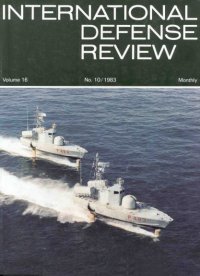 |
| Firepower – The Weapons the Professionals Use – and How. Published weekly by Orbis Publishing Limited / Aerospace Publishing Ltd, London, 1990. Volume 3, Issue 33 features the US Navy’s PEGASUS class hydrofoil HERCULES (PHM 3) on the cover and provides the general particulars of that class and other dynamically supported and conventional fast attack craft in its contents. 23 pages of text and photos. | 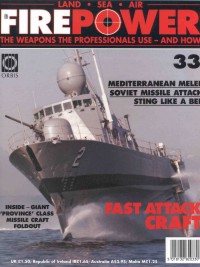 |
| Navy International, Vol. 78, No. 11, November 1973. Published by Maritime World Ltd, Surrey, UK. This issue features the Italian Navy hydrofoil SWORDFISH (P 420) on the cover and a four page article of the Nibbio class hydrofoil following sea trials of the first of the class. There is also a five page article of the US Navy’s Surface Effect Ship program in this issue. |  |
| Zimm, LCDR Alan D., US Navy, “PHMs: Unique Ships, Unique Problems, Proceedings, Volume 108/2/948 February 1982, pp 90-93. Proceedings is published monthly by the US Naval Institute, Annapolis, MD, USA. ISSN 0041-798X. The cover of this issue features USS TAURUS (PHM-3) taking a tight turn during tests at Puget Sound. The article in this issue deals with the complexities of how to manage the PHM in the USN fleet and the need for doctrine and tactics to suit the unique characteristics of the class. The article responds in part to an earlier article by LCDR Linder entitled “PEGASUS: Winner or Also-Ran?” published in the Sep 1981 issue of Proceedings .The well known aerial photo of a PHM executing a “Figure 8” is captioned, “Is the PHM here demonstrating the maneuverability of the ship or the direction of the PHM program?” |  |
| Jane’s Defence Weekly, Volume 2, Number 7, 19 August 1989. As the title suggests, JDW is a weekly defence journal. From time to time, items concerning naval hydrofoils will appear in the weekly. This particular issue features a cover photo with an Italian Navy Sparviero class (also known as Nibbio class) hydrofoil, and subtitle ‘Japan opts for Italian hydrofoils’. A half page article by Kensuke Ebata in Tokyo notes that the Japanese Defence Agency has requested three Italian Sparviero class hydrofoil missile boats for its Maritime Self Defence Force in its FY90 budget. The hydrofoils were to be built under license in Japan. | 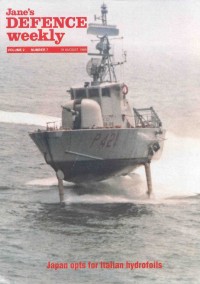 |
| “HIGH POINT Joins the Navy,” Undersea Technology, Nov 1963, Vol. 4, No. 11, Compass Publications, Inc. Arlington VA 22209, p.23. Introductory text and four B&W photos. From the text: “The new hydrofoil craft HIGH POINT , has entered the service as the Navy’s first operational hydrofoil craft. Largest hydrofoil in the Nation, she’s currently undergoing extensive testing at Puget Sound, Washington. The 110-ton ship, designed by the Navy’s Bureau of Ships and built by the Boeing Company, will soon head south to join the Pacific Fleet… armament on the HIGH POINT consists of four MK 32 torpedo tubes, two on each side, and a .50 cal. machine gun mounted just forward of the pilot house.” |  |
| Farther, Spring 1987 (Vol. 2, No. 1) PHM-1 USS PEGASUS cover. Article about PEGASUS. Back in the 1980s, Electronic Arts published a magazine that was sent to people that registered their software. These magazines featured game news and interviews with the creators. It’s not just marketing hype – there’s some good content also. No further (Farther!) information available. | 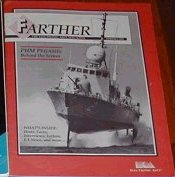 |
More Military Magazine Titles (No Photo Available)…
|
|
| Multihulls Magazine, Volume 25, Number 3, May/June 1999. ISSN 0749-4122. www.multihullsmag.com e-mail: multimag@aol.com Editor: Charles K. Chiodi. The magazine is published bimonthly and from time to time may feature articles concerning hydrofoil-supported multihull sailboats. This issue includes a two-page article with photo by Dave Carlson titled “Foiling with one of the Giants”. The article describes Dave Carlson’s experience with working on and sailing a foil-supported Hobie 18 designed by the late Dave Keiper. For updates on Dave Carlson’s continued work with foil kits in Gainesville FL, visit his website or contact him by email. | 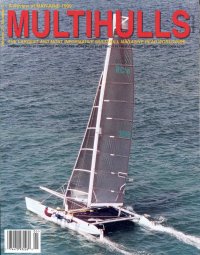 |
| Multihulls Magazine, May/June 1990 Issue. Cover illustration is of the Hobie TRIFOILER | 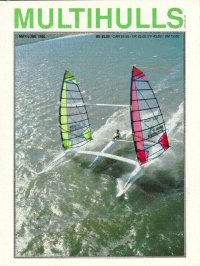 |
| Multihull World Magazine – Power and Sail, Number 47. ISSN 1034-5108. www.multihull.com.au / email: info@multihull.com.au. Editor: Paul Lynch, P&G Lynch and Associates. Issue 47, published early in 2000 features a cover with an artist’s impression of the VOLANTIS designed and to be built by HydroWing Hawaii. The four page article on this design includes a three view drawing of this 60 foot hydrofoil sailing vessel. The design has been co-developed by Sam Bradfield (hydrofoils), David Hubbard (sails) and Nigel Irens (hull). The goals of the VOLANTIS are described as “to capture the world’s speed record for sail powered craft, to break the world’s 24 hour distance record for sailing and to set new course records for open ocean races worldwide.” Other articles on VOLANTIS have been published in Seahorse Magazine (Nov.2000), Multihulls Magazine (Mar/Apr 2000), Composites Fabrication (March 2000), Canadian Yachting Magazine (Regatta 2000), and Yachting World (July[??] 2000). |  |
| Yachting, April 1929. Contains article on 30-foot hydrofoil, text and photos. No other information available. If anyone can provided a photocopy to IHS, it will be greatly appreciated. Contact the webmaster@foils.org. |  |
| Vincent, R. E., “Beware Low Flying Boats — An Experimental Hydrofoil Craft With an Ingenious Theory for Stability,” Yachting World, May 1972, pp 98-99, IPC Transport Press Ltd, London, publishers. Article by a post-grad student. Paragraph headings are: Design Objective, Apparent Wind Analysis, Propulsion Device, Transverse Stability, Longitudinal and Directional Stability, Resultant Overall Design, Predictions of Future Developments, and Conclusion.
“Offshore at 40 knots,” Yachting World May 1998, pp 16-19. No details available. |
 |
| Yachting World International, May 2002, Volume 154, Issue no. 3125. For more information on this magazine see www.yachting-world.com . This issue features the French sailing hydrofoil L’HYDROPTERE on the cover. The issue has 26 pages of content on the theme of “Greed for Speed”. Articles include “Speed Pioneers” tracing the history of speed sailing at the Portland Speed Week prepared by David Pelly, “Offshore record breakers” by James Boyd, “Breaking the 50-knot barrier?” by Matthew Sheahan, and “Pushing the Boundaries” by Elaine Bunting. There are nice photographs of the hydrofoil catamarans Spitfire, Techniques Avancees, Mayfly and Icarus, the small hydrofoil trimarans FORCE 8 and LONGSHOT, and the hydrofoil-supported trimarans PAUL RICARD and L’HYDROPTERE along with other fast sailing craft. | 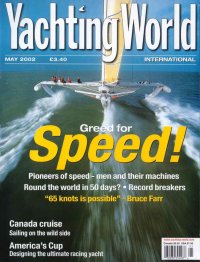 |
Johnston, Robert J., “Hydrofoils, Ships That Fly,” The Rudder, the Magazine for Yachtsman, The Rudder Publishing Co., 9 Murray St, NewYork 7, NY, Nov 1953, Vol. 69 No. 11, pp 30 – 33. Included 9 small B&W photos. Bob Johnston wrote this article as a Lieutenant Commander in the US Navy, serving as Hydrofoil Project Officer for the Mechanics Branch of the Office of Naval Research (ONR). The article traces the history of hydrofoil development through the contemporary date in 1953. Among the hydrofoils described are:
|
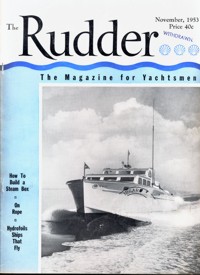 |
| Carl, William P., “The Fantastic Hydrofoil Runabout – Its Development and Future,” The Rudder, Aug 1958 – How SEA WINGS hydrofoils developed from bathtub hobby to commercial reality. “This story begins in 1938, in Bob Gilruth’s bathroom… he started with 6-inch models…from the model tests, a full scale, 12-foot sailing catamaran with hydrofoils, CATAFOIL I was built and operated in the Chesapeake for several years.” The author started a collaboration with Bob Gilruth in 1943 that led to to world’s fastest open sea waterborne vehicle — the XCH-4. But the US Navy turned down the idea of an 80 knot patrol boat, so the author turned to commercial products. In October 1955 he tested SYNOTROPUSS, an 8-foot rowboat with fiberglass foils and 7 hp outboard that made speeds over 30 mph. The next test craft was a 16-ft Goodyear family runabout fitted with foils that could do 34-mph. In August 1956, the author associated himself with Grumman Aircraft engineering Corp. After months of testing a foil-equipped 15-ft aluminum runabout in Florida, the Grumman boat was placed on the market at the New York Boat Show, January 1957. Unfortunately, “there were so many man-hours of labor involved in production it put the cost out of reach of the mass market.” At the time this article was written, a new type of mount had been developed to allow the Sea Wing foils to be attached to many makes of 14- to 16-ft runabouts. |  |
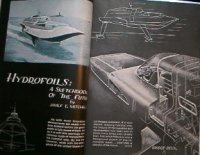
|
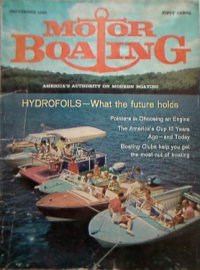 |
| Joseph, James, “Wings for Your Boat; The Astonishing Story of Hydrofoils, Powerboat Oct 1960, pp 8-13, 68-69. Explanation of how hydrofoils work and a nice survey of existing and planned hydrofoils for pleasure, commercial, and military uses. The vessels depicted in the article’s 15 photos are Midwest Hydrofofin Co.’s foil kit (featuring the Christopher Hook concept of “wave-sensing skids which ride in front of boat”), Evinrude Motors’ dreamboat JETSTREAM by designer Brooks Stevens, Baker Manufacturing’s experimental Navy craft HIGH POCKETS with tandem surface-piercing foils, Rodrigues passenger boats operating in the Mediterranean, the XCH-4 designed for the Navy by William P. Carl with seaplane hull supported by two sets of foils forward and a single strut and foil aft, a Grumman concept passenger craft designed for the US Maritime Administration, two workboat models (one numbered MA-2133), and HALOBATES, a gas-turbine powered converted LCVP. |  |
More Yachts, Sailboats, and Motorboats Titles (No Photo Available)…
|
|
| Johnson, Frank, “1/32 Scale German VS8 Hydrofoil,” Scale Ship Modeler, Jul 82, Vol. 5, No. 4, Challenge Publications, Inc., Canoga Park CA 91304, pp 44 – 49, 57-59. The article is about the kit offered by 32nd Parallel Corp, now defunct, and is a must for anyone with this kit. The article includes 11 generously-large photos, of which 4 are in color. The text is historical information, description of the kit and of 32nd Parallel Corp. There is nothing in the way of detailed tips based on experience as to how to assemble or operate the kit (note: the IHS correspondence archives on R/C models contain discussion of operating problems and possible solutions). The author is formerly of the staff of Sea Classics Magazine. From the text: “…the VS-8 was a magnificent machine, beautiful in every respect and highly advanced for its time. Aside from the fact that the prototype’s 103-foot length made it the perfect size for 1/32 scale modeling (producing a 38.5 inch hull), it would also be the first hydrofoil (not to mention the first scale hydrofoil) ever offered in an operational R/C construction kit.” | 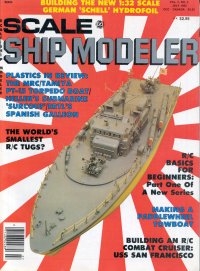 |
Marine Modelling International – Plans and Construction Guide, 1998, Traplet Publications Ltd, Worcestershire, England. This guide features the RAPIER hydrofoil model (plan number MAR2392) designed and constructed by Graham Taylor on the front cover. There is also a photo and brief description of this 950mm long model designed for up to .40 sized internal combustion engines in the guide, but further details are contained in the December 1992 issue of the Marine Modeling Monthly magazine. See also “Wings Under Water; Graham Taylor Discusses Model Hydrofoils”, Marine Modeling Monthly, August 1991. For further details and photos of Graham Taylor’s two neat hydrofoil models, see his website. Here are citations taken from the site:
|
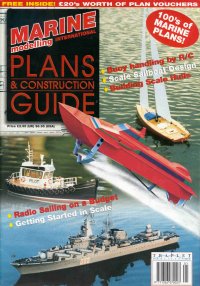 |
| Model Boats, Vol.47, No.558, 27 June 1997. ISSN 00819-8277. Published by Nexus Special Interests Limited, UK. Features a four page article with 13 photos and a small arrangement drawing of the Zytiron 24 model racing hydrofoil produced by Hydrofoils, Inc. This model is no longer produced.
(not shown) Model Maker & Model Boats, Jan 1966, “The British monthly journal for all model makers,” includes an article on Japanese hydrofoil models. No details available. |
 |
| Bruce, Ian, “Hydrofoil Craft,” Meccano Magazine, Oct 59, Vol XLIV No. 10, pp 427 – 429, published in Liverpool England. Discussion of hydrofoil craft of the time, history, advantages over conventional craft, and explanation of how hydrofoils work. Photos of the first Saunders-Roe R-103 BRAS D’OR (re-named BADDECK in 1962 in anticipation of the construction of the larger FHE-400 which was to be given the name BRAS D’OR) and a Supramar PT-20. There is no information in the article about how to model the vessels discussed. From the text of the article: “.Compared to other types of speedboats of equal size, hydrofoil boats possess many important advantages. For instance, only half the engine power is required to attain the same speed. Fuel consumption is reduced by as much as half, and consequently the cruising range is nearly doubled. Economy in fuel, as well as the possibility of covering an increased daily distance as a result of much higher speeds, results in in a reduction of about 30 percent in operating costs.” |  |
| Gue, Frank, “Hydrofoils, a new dimension,” Radio Control Modeler, published by R/C Modeler Corp., 120 W. Sierra Madre Blvd; Sierra Madre CA 91024. Vol. 17 No. 5, May 1980, ISSN 0033-6866, pp. 72, 82, 84, 86-87, 90. Includes one line drawing and two small B&W photos. The author describes his successful experiments with hydrofoil landing gear on a 60″, .19-powered model airplane test bed. He created a series of model planes, logging over 1,500 flights at the time of the article. The article includes many tips on design, waterproofing, and operation. Quotes from the article: “A hydrofoil, fitted to an aircraft, lifts the immersed parts clear of the water so that displacement drag is eliminated. It also cures the glassy water syndrome, which can literally prevent respectable airplanes from taking off at all. The famous Canso patrol flying boat was subject to this… wavelets of two or three inches (scale height of more than one foot) don’t bother the model at all. On long swells, it glues down beautifully while planing, thanks to its tricycle configuration until flying speed is reached, at which time it generally launches itself spontaneously for the top of the first swell over which it has airspeed…. Flying off hydrofoils is truly a new dimension to this marvelous hobby of ours. Try it! You’ll like it!” | 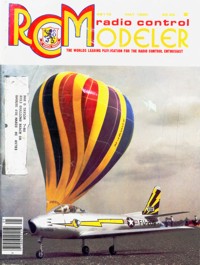 |
| Radio Control Boat Modeler, Vol.10, No.2, February 1996. ISSN 1043-8009. Published seven times a year by Air Age, Inc, Wilton CT, USA. Features a three page articles with photos of a 24-inch long fast electric hydrofoil model produced by Hydrofoils, Inc. This model is no longer produced. |  |
| Musciano, Walter A., “von Schertel’s VS-6 Hydrofoil Patrol Boat,” Young Men (formerly Air Trails Hobbies for Young Men) Nov 1955 Vol. 45 No. 2, Street & Smith Publications, Inc., New York. pp 34-35, 86. Article contains parts list, cutaway illustration, exploded view of structure assembly, and teensie-weensie plan (the full size plans were available by mail order for 50 cents: Hobby Helpers Plan #1155). The article explains a bit of hydrofoil history. An experienced modeler who wanted to model the VS-6 would find this article helpful, but the plan is tiny and short on dimensions. Too bad Hobby Helpers went out of business years ago. Some of their plans for model aircraft have been preserved and copied onto modern drafting media for sale, but it is unlikely the hydrofoil plan is available anywhere. The Hobby Helpers plans were printed on cheap paper, not designed to endure over many years.
Air Trails Hobbies for Young Men, July 1955, has plans for a for “Water Warrior” hydrofoil. No further info available. |
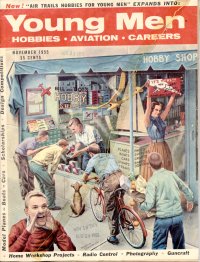 |
More Model Magazine Titles (No Photo Available)…
|
|
| Levy, Howard, “HRV-1 Hydrofoil Amphibian,” Air Progress – The News Magazine of Aviation, Condé Nast Publications, New York, Feb 1968, vol 22 no. 2, pp. cover, 38-39, 73-74. “… the hydrofoil seaplane can operate in sea states three times the size safely handled by a basic seaplane… For almost five years, David B. Thurston, President of… Thurston Aircraft Corporation of Sanford Maine has been conducting relatively unpublicized hydro-ski and hydrofoil development and flight evaluation programs for the US Naval Air Systems Command (NAVAIRSYSCOM)… It was during Spring 1964 that the Naval Air Test Center at Patuxent conducted an evaluation of an Edo-developed Grunberg hydrofoil on a Grumman JRF-5G… A second generation seaplane hydrofoil configuration called for a single, small foil positioned below the hull. The resulting design was a single supercavitating, penetrating hydrofoil considered suitable for use on the Grumman Hy-16 Albatross… a modified 1960 Lake LA-4A Skimmer amphibian was chosen as a scale flight test bed.” Note, a summary of David B. Thurston’s accomplishments is posted on the web, and includes information about his work with hydrofoil amphibians at Thurston Erlandson Corp |  |
| de Cenzo, Herbert A., “Analysis of the Possibilities Presented by Hydrofoil Equipped Aircraft, Aero Digest June 1, 1944, Vol. 45, No. 5, Aeronautical Digest Publishing Corp. New York, pp 70-73, 128, 130. Interesting discussion of the various issues, including artist concept drawings of a jet-propelled hyplane. From the text: “The following analysis is presented to point out some of the advantages and disadvantages of hydrofoil-equipped aircraft, referred to herein as “hyplanes”… Water-based aircraft are usually of two types, namely, flying boats and seaplanes… to simplify this analysis… it is presented in two parts. The first part deals with seaplanes, while the second is devoted to flying boats… The results obtained rate the land plane, the hyplane, the flying boat, and the seaplane… the seaplanes and larger flying boats are definitely outperformed by the hyplanes. However, in the small flying boat class it is questionable from a practical standpoint if the hydrofoil-equipped airplane would be the best… In conclusion, the opinion is ventured that most of the long-range, heavy-load carrying airplanes of the future will be jet-propelled hyplanes.” | 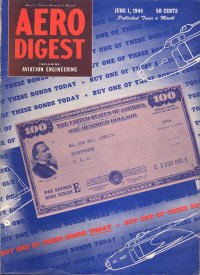 |
